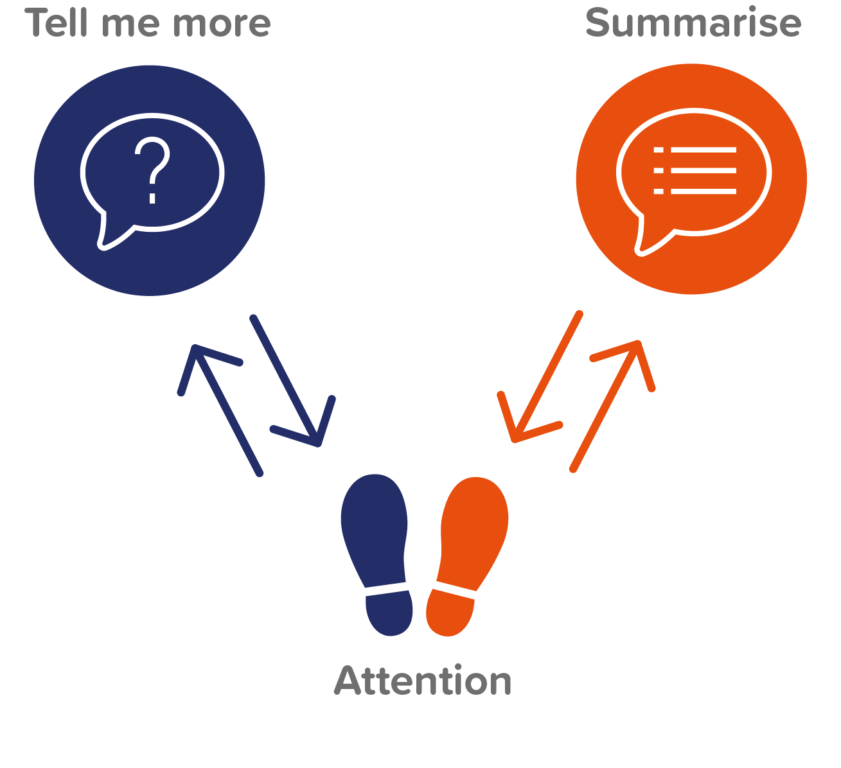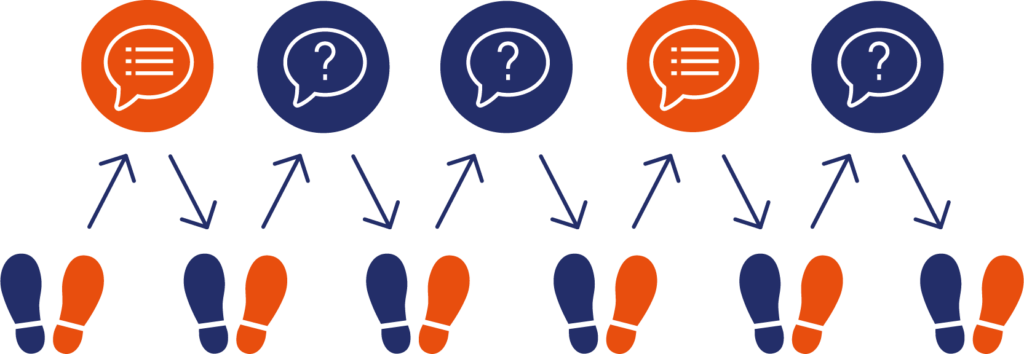
Use the Coaching Two-Step to help your executives and colleagues articulate more clearly what they want, explains Jude Sclater
On an average day, how often do your colleagues come to you with problems they should be able to solve themselves?
It’s frustrating, isn’t it? Why can’t people use their initiative and work it out?
The hard truth is, you’re the reason.
You might think you’re being helpful by fixing their problems all the time, but what you’re really doing is making them reliant on you. Why would your colleagues bother thinking for themselves when you give them the answers for free?
So, what can you do instead? I’d suggest you try to think like a coach.
What Does It Mean to Think Like a Coach?
Coaching is giving someone your attention while they think aloud and asking questions to help them discover their own solutions to act on.
In practice, this means switching from telling your colleagues the answers to asking them questions to help them work it out for themselves. A manager from my Think Like A Coach workshop excitedly told me that making this switch meant her team had achieved more in six weeks than they had in the last three months. It took a little more time to begin with, but her team became more confident and self-sufficient, so she was able to shift her attention to bigger projects.
This doesn’t mean you should never give your colleagues the answer. What I’m encouraging you to do is to be curious and ask some questions to give them a chance to work it out before offering your own ideas.
Get Your Dancing Shoes On
Learning to coach is like learning to dance; it’s a bit awkward at first and you might feel self-conscious. With a little practice, you’ll be doing the moves without even thinking about it, adding your own style and flair.
I know you can do it because it uses skills you already have, such as:
- giving someone your best quality attention while you’re listening to what they have to say,
- keeping them talking by asking “Tell me more,” and
- summarising what you’ve heard to show you’ve been listening and understanding.

[Image: Coaching Two-Step®]
How to Use the Coaching Two-Step
Next time a colleague comes to you with a problem, stop what you’re doing and give them your best quality attention, listening with curiosity to what they have to say. When they’ve finished talking, you have two options:
- ask them to “tell me more”; or
- summarise the essence of what you’ve just heard.
These two options are free of judgement or opinion and empower your colleagues to think for themselves.
Once you’ve tried one of these options, go back to silently giving them your best quality attention. When they finish, you have the choice between the two options again and the conversation continues. If it were a dance, it might look like this:

[Image: Coaching Two-Step® in action]
Limiting yourself to these two options when your colleague asks a question helps you hold back your urge to be helpful. And by helpful, I mean solving the problem for them. When your colleague produces their own solutions, they’re more committed to acting on them and take more responsibility over them.
Another way you can use the Coaching Two-Step is when you need to help your executive articulate more clearly what they actually want. By asking “tell me more” you’ll get the real reason the task or project is important to them. Summarising back what you’re hearing will encourage them to tell you anything they’ve missed. This will enable you to deliver exactly what they expect and eliminate the back and forth caused by unclear expectations.
Once you’ve tried each option at least once, then trust your intuition on what questions to ask next. After each question use the Coaching Two-Step to help your colleague or executive to expand more on their thinking.
Let’s look at each element in more detail.
Attention
I do an exercise where I put people into pairs. One is the speaker and the other the listener. The speaker has 90 seconds to talk about something they’re looking forward to. The listener is told to appear distracted. Guess what happens.
The speaker’s speech becomes less fluent and coherent with lots of pauses, ums, and ahs. They report feeling frustrated or irritated and they keep losing their train of thought. Many also start wondering why they are bothering at all.
Attention is the most important element of the Coaching Two-Step, and I’d argue the most important coaching skill you can develop. If all you do is work on improving the quality of your attention, your relationships will improve dramatically.
Along with attention comes silence, which for many of us feels very uncomfortable. When you ask questions that cause someone to do new thinking, there will be silence. Embrace it; it means your coaching efforts are working. When someone is thinking, they’ll be looking everywhere but at you, so hold the silence and let them fill it when they’re ready.
Tell Me More
The purpose of asking your colleague “tell me more” is to encourage them to keep thinking aloud. You know those times you’ve been stuck on something, and the answer magically comes to you as you’re telling someone else your problem? That’s what you’re trying to replicate.
When you say something aloud, you process the information differently than you do when you’re thinking about it in your head. So, get the other person to tell you more about their problem. The more they talk the more likely they are to solve the problem for themselves.
It can get cumbersome asking the same question, so here are some alternatives:
- How do you feel about that?
- What do you think about that?
- What’s most important for you?
Summarise
When you summarise what you’ve heard, you show that you’ve been listening, which is a signal for your colleague that this is a safe space to think. Your colleague also gets the added benefit of hearing you repeat their words back to them, which gives them another way to process the information.
Keep your summary short; you don’t need to parrot everything back – just the essence of what you’ve heard. The more you talk, the less the other person is thinking. And don’t worry about getting it wrong; your summary is another way of asking “Tell me more.” Your colleague will fill in any gaps.
Outcome-focused Questions
Often people are so concerned with their problem, they haven’t thought of what their ideal solution would be. After using both options of the Coaching Two-Step at least once, try asking an outcome-focused question like:
- What’s your ideal outcome?
- What do you want to happen here?
- What’s the best outcome for you?
Then use the Coaching Two-Step to explore their answers more. This creates a destination for your colleague or executive. They already know where they are now, and once they know where they want to be it’s easier to see the options to get there.
Give the Coaching Two-Step a Go
You now have everything you need to give the Coaching Two-Step a go in your next conversation. Don’t worry about getting it right; pick an element of the Two-Step and give it a go. I know you can do it.








